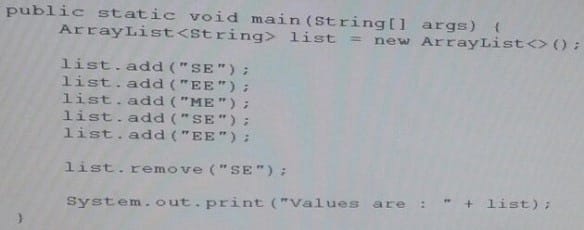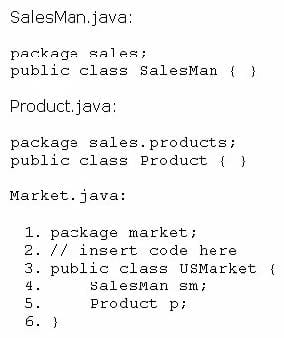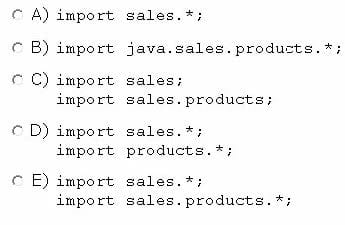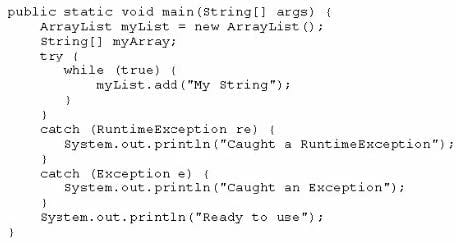Exam Details
Exam Code
:1Z0-808Exam Name
:Java SE 8 Programmer ICertification
:Oracle CertificationsVendor
:OracleTotal Questions
:385 Q&AsLast Updated
:Jul 05, 2025
Oracle Oracle Certifications 1Z0-808 Questions & Answers
-
Question 271:
Given:

A. 100 200 : 0 0 :
B. 100 200 : 100 0 :
C. 100 200 : 100 200 :
D. 0 0 : 100 0 :
-
Question 272:
Given the code fragment:
int b = 3;
if ( !(b > 3)) {
System.out.println("square ");
}{
System.out.println("circle ");
}
System.out.println("...");
What is the result?
A. square...
B. circle...
C. squarecircle...
D. Compilation fails.
-
Question 273:
Given the code fragment:

What is the result?
A. Values are : [EE, ME]
B. Values are : [EE, EE, ME]
C. Values are : [EE, ME, EE]
D. Values are : [SE, EE, ME, EE]
E. Values are : [EE, ME, SE, EE]
-
Question 274:
Given:
public class TestLoop1 {
public static void main(String[] args) {
int a = 0, z=10;
while (a < z) {
a++;
--z;
}
System.out.print(a + " : " + z);
}
}
What is the result?
A. 5 : 5
B. 6 : 4
C. 6 : 5
D. 5 : 4
-
Question 275:
Given the code fragment:
public class ForTest {
public static void main(String[] args) {
int[] array = {1, 2, 3};
for ( foo ) {
}
}
Which three code fragments, when replaced individually for foo, enables the program to compile?
A. int i : array
B. int i = 0; i < 1;
C. ; ;
D. ; i < 1; i++
E. i = 0; i<1;
-
Question 276:
Given:
public class Marklist {
int num;
public static void graceMarks(Marklist obj4) {
obj4.num += 10;
}
public static void main(String[] args) {
MarkList obj1 = new MarkList();
MarkList obj2 = obj1;
MarkList obj1 = null;
obj2.num = 60;
graceMarks(obj2);
}
}
How many objects are created in the memory runtime?
A. 1
B. 2
C. 3
D. 4
-
Question 277:
Given the code fragment from three files:

Which code fragment, when inserted at line 2, enables the code to compile?

A. Option A
B. Option B
C. Option C
D. Option D
E. Option E
-
Question 278:
Given the code fragment: What is the result?

A. Execution terminates in the first catch statement, and caught a RuntimeException is printed to the console.
B. Execution terminates In the second catch statement, and caught an Exception is printed to the console.
C. A runtime error is thrown in the thread "main".
D. Execution completes normally, and Ready to us?is printed to the console.
E. The code fails to compile because a throws keyword is required.
-
Question 279:
Given:
public class Test {
static boolean bVar;
public static void main(String[] args) {
boolean bVar1 = true;
int count =8;
do {
System.out.println("Hello Java! " +count);
if (count >= 7) {
bVar1 = false;
}
} while (bVar != bVar1 andand count > 4);
count -= 2;
}
}
What is the result?
A. Hello Java! 8 Hello Java! 6 Hello Java! 4
B. Hello Java! 8 Hello Java! 6
C. Hello Java! 8
D. Compilation fails
-
Question 280:
Which three statements describe the object-oriented features of the Java language?
A. Objects can be reused.
B. A subclass can inherit from a superclass.
C. Objects can share behaviors with other objects.
D. A package must contain more than one class.
E. Object is the root class of all other objects.
F. A main method must be declared in every class.
Related Exams:
1Z0-020
Oracle8i: New Features for Administrators1Z0-023
Architecture and Administration1Z0-024
Performance Tuning1Z0-025
Backup and Recovery1Z0-026
Network Administration1Z0-034
Upgrade Oracle9i/10g OCA to Oracle Database OCP1Z0-036
Managing Oracle9i on Linux1Z0-041
Oracle Database 10g: DBA Assessment1Z0-052
Oracle Database 11g: Administration Workshop I1Z0-053
Oracle Database 11g: Administration II
Tips on How to Prepare for the Exams
Nowadays, the certification exams become more and more important and required by more and more enterprises when applying for a job. But how to prepare for the exam effectively? How to prepare for the exam in a short time with less efforts? How to get a ideal result and how to find the most reliable resources? Here on Vcedump.com, you will find all the answers. Vcedump.com provide not only Oracle exam questions, answers and explanations but also complete assistance on your exam preparation and certification application. If you are confused on your 1Z0-808 exam preparations and Oracle certification application, do not hesitate to visit our Vcedump.com to find your solutions here.